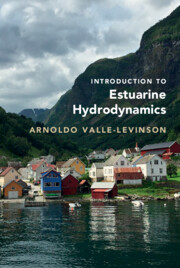Book contents
- Introduction to Estuarine Hydrodynamics
- Introduction to Estuarine Hydrodynamics
- Copyright page
- Contents
- Preface
- 1 Introduction and Classification
- 2 Conservation Equations
- 3 Tides in Semienclosed Basins
- 4 Shallow-Water Tides
- 5 Tidal Residual Flows in Homogeneous, Semienclosed Basins
- 6 Wind-Driven Flows in Homogeneous, Semienclosed Basins
- 7 Flows Driven by Density Gradients
- 8 Interactions among Tides, Density Gradients, and Wind
- 9 Fronts
- 10 Time Scales in Semienclosed Basins
- 11 Semienclosed Basins with Low or No Discharge
- 12 Classification of Semienclosed Basins, Based on Dynamics
- Index
- References
12 - Classification of Semienclosed Basins, Based on Dynamics
Published online by Cambridge University Press: 24 February 2022
- Introduction to Estuarine Hydrodynamics
- Introduction to Estuarine Hydrodynamics
- Copyright page
- Contents
- Preface
- 1 Introduction and Classification
- 2 Conservation Equations
- 3 Tides in Semienclosed Basins
- 4 Shallow-Water Tides
- 5 Tidal Residual Flows in Homogeneous, Semienclosed Basins
- 6 Wind-Driven Flows in Homogeneous, Semienclosed Basins
- 7 Flows Driven by Density Gradients
- 8 Interactions among Tides, Density Gradients, and Wind
- 9 Fronts
- 10 Time Scales in Semienclosed Basins
- 11 Semienclosed Basins with Low or No Discharge
- 12 Classification of Semienclosed Basins, Based on Dynamics
- Index
- References
Summary
A classification of semienclosed basins is proposed in this chapter by following a tidally averaged momentum balance that compares drivers and modifiers of residual flow. Residual flow drivers are characterized by the nondimensional tidal Froude number, while balancing forces are typified by the Ekman number. Thus, the classification is contained in a parameteric space that considers estuaries, tidal rivers, vertically homogeneous lagoons, and frictionless tidal basins. The scheme can be regarded as the baroclinic tendencies shown by any basin, presented in the abscissa, versus the mixing tendencies, as represented in the ordinate. Also considered are situations in which wind stress competes with (a) density gradients and (b) tidal stress. This additional approach allows a dynamic description of basins where the dynamics are purely frictional, non-frictional (geostrophic), and Ekman-type. This classification includes semienclosed basins beyond estuaries.
Information
- Type
- Chapter
- Information
- Introduction to Estuarine Hydrodynamics , pp. 190 - 202Publisher: Cambridge University PressPrint publication year: 2022
